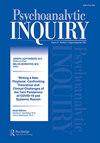前言:虚构人物:精神分析和文学视角
IF 0.5
4区 心理学
Q3 PSYCHOLOGY, PSYCHOANALYSIS
引用次数: 0
摘要
虚构人物是真人吗?当然不是。根据定义。即使他们的部分灵感来自一个或多个真实的人。但如果它们不是真实的,我们为什么要关心它们来读小说呢?此外,为什么在过去的几十年里,普通读者对虚构人物的反应与许多文学理论家的反应之间存在着如此深刻的脱节,他们告诉我们,这些人物只是页面上的文字,推测他们的心理或背景故事是荒谬的?在大学里,我参加了一个关于小说的比较文学研讨会,这些小说在情节中公开或更频繁地微妙地暗示了耶稣的生活。也就是说,小说的主人公以耶稣的生活为突出背景,为他们的人物增加了深度。我们的老师后来根据我们研讨会的主题出版了一本书(Ziolkowski,1972)。这门课让我意识到,一个虚构人物可能有一个重要的背景故事,包括一个文学典故,这将丰富我们对这本书的体验。本期的灵感来自一篇书评。波莫纳学院的Evan Kindley在2021年3月25日的《纽约书评》上写了一篇题为《我们最了解的人》的文章(Kindley,2021)。标题下面出现了这些挑衅性的、富有创造性的陈述:“读者喜欢虚构人物,就好像他们是真实的人一样。文学学者才刚刚开始更认真地对待他们。”这利用了我长期以来对文学理论方向的担忧,淡化了真实作家和小说读者的角色。在这个过程中,它削弱了以前与真正的精神分析观点的牢固联系。在引用了关于虚构人物本质的广泛观点后,Kindley总结道,“学术文学批评的一个奇怪事实是,这种……观点[L.C.Knights的观点,他写道虚构人物‘只是读者心目中的抽象’]尽管对大多数人来说,文学人物是最不直观、最不吸引人的,但近一个世纪以来,文学人物一直是主流。事实上,文学评论家在谈论人物时一直严格要求读者(以及彼此)的监督”(2022年9月17日在线访问)。精神分析家必然对深入研究小说和虚构人物对读者意味着什么特别感兴趣,包括我们的病人(例如,Novey,1964)。我们的理论是一种发展理论,所以我们希望从父母的阅读开始,找到我们的故事经历的发展路线;小时候读图画书,然后读章节书;然后在青少年时期和以后遇到成人小说。孩子们花了很多时间在他们想象的世界里(Selma Fraiberg,1959,the Magic Years)。Fraiberg认为,“语言源于魔法”(第112页),因为婴儿牙牙学语的“魔法咒语”有时会“带来一个想要的事件”,比如当他第一次说“妈妈”时,母亲脸上露出灿烂的笑容。当成年人读小说取乐时,童年的自我状态会神奇地复活。威廉·施莱格尔(Wilhelm Schlegel)观察到,莎士比亚尤其将我们与我们想象力的童年来源联系在一起,这样我们就可以更好地理解和欣赏他的戏剧(“对童年来说……有吸引力和可理解的故事……它们甚至将成年带回了想象力的黄金时代,”施莱格尔,1815年,第387页)。多年来,我与一位英语教授朋友进行了许多富有启发性的对话,他也接受过许多精神分析方面的非临床培训。我们都热爱创意本文章由计算机程序翻译,如有差异,请以英文原文为准。
Prologue: Fictional Characters: Psychoanalytic and Literary Perspectives
Are fictional characters real people? Of course not. By definition. Even when they’re partially inspired by one or more actual people. But if they’re not real, why do we care about them enough to read fiction? Further, why has there been such a profound disconnect for the past several decades between general readers’ reactions to fictional characters, and those of many literary theorists, who tell us such characters are merely words on the page, and that it is absurd to speculate about their psychology, or their backstory? In college, I took a comparative literature seminar on novels that openly or – more often – subtly alluded in their plots to the life of Jesus. That is, the novels’ protagonists had the life of Jesus as a salient backdrop, adding depth to their characters. Our teacher later published a book based on the topic of our seminar (Ziolkowski, 1972). That course sensitized me to the possibility that a fictional character can have an important backstory – including one of literary allusion – that will enrich our experience with the book. This issue was inspired by a book review. Evan Kindley of Pomona College, in the March 25, 2021 New York Review of Books, wrote an essay titled “The People We Know Best” (Kindley, 2021). Below the title appeared these provocative and generative statements: “Readers love fictional characters almost as if they were real people. Literary scholars are just starting to take them more seriously.” This tapped into longstanding concerns I have had about the direction that literary theory has taken, downplaying the roles of actual writers and readers of fiction. In the process, it has weakened its previously robust connection with a truly psychoanalytic view of the mind. After citing a wide range of opinions about the nature of fictional characters, Kindley concludes, “A strange fact about academic literary criticism is that this . . . view [that of L.C. Knights, who wrote that fictional characters are ‘merely an abstraction . . . in the mind of the reader’] – that literary characters don’t even exist – has been the predominant one for almost a century, despite being the least intuitively satisfying and attractive one to most people. Indeed, literary critics have been strict about policing readers (and one another) when it comes to talking about character” (accessed online September 17, 2022). Psychoanalysts are bound to a have special interest in studying in depth what fiction and fictional characters mean to readers, including readers who are our patients (for example, Novey, 1964). Ours is a developmental theory, so we would expect to find a developmental line of our experiences with stories, beginning with being read to by a parent; reading picture books, then chapter books as a child; then encountering adult fiction as an adolescent and beyond. Children spend much time in the world of their imagination (Selma Fraiberg, 1959, The Magic Years). Fraiberg contends that “language originates in magic” (p. 112), as the baby’s babbling “magical incantations” sometimes “bring about a desired event,” such as a radiant smile on his mother’s face when he first says “mama.” And childhood self states are magically revived when adults read fiction for pleasure. Wilhelm Schlegel observed that Shakespeare, in particular, connects us with the childhood sources of our imaginative capacities so we can better understand and enjoy his plays (“tales which are . . . attractive and intelligible to childhood . . . they transport even manhood back to the golden age of imagination,” Schlegel, 1815, p. 387). For years, I have had many illuminating conversations with a friend who is an English professor, and who has also had much non-clinical training in psychoanalysis. We share a love of creative
求助全文
通过发布文献求助,成功后即可免费获取论文全文。
去求助
来源期刊

Psychoanalytic Inquiry
PSYCHOLOGY, PSYCHOANALYSIS-
CiteScore
1.00
自引率
33.30%
发文量
65
期刊介绍:
Now published five times a year, Psychoanalytic Inquiry (PI) retains distinction in the world of clinical publishing as a genuinely monographic journal. By dedicating each issue to a single topic, PI achieves a depth of coverage unique to the journal format; by virtue of the topical focus of each issue, it functions as a monograph series covering the most timely issues - theoretical, clinical, developmental , and institutional - before the field. Recent issues, focusing on Unconscious Communication, OCD, Movement and and Body Experience in Exploratory Therapy, Objct Relations, and Motivation, have found an appreciative readership among analysts, psychiatrists, clinical psychologists and a broad range of scholars in the humanities.
 求助内容:
求助内容: 应助结果提醒方式:
应助结果提醒方式:


